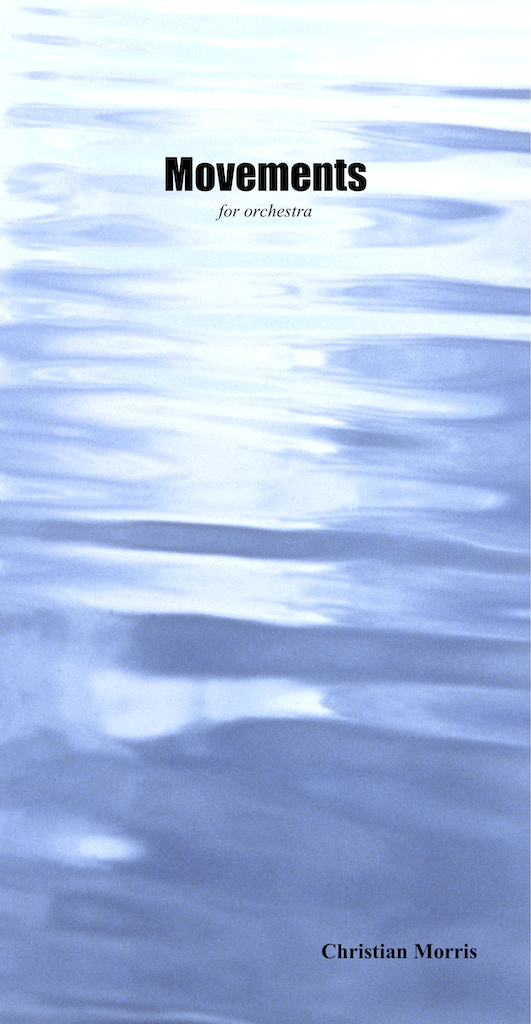
This work, as the title implies, explores different types of movement in a musical argument that spans the whole work.
1. World Cup Terrace
The inspiration from this movement came from the random sound of horns in the crowd whilst I was watching a World Cup match on the television. This can be heard in the opening bars, though the idea is transformed into something rather more controlled. The opening stabbing chords, which contain a note cell responsible for much of the thematic material throughout the piece, seem to set in motion a note cluster beginning in the lowest instruments. This works its way upwards through the orchestra, finding points of rest along the way – on D (already implied at the start), C# and B. At the end the upward movement seems to collapse back towards the opening tessitura, but the violins continue upwards on high clustered harmonics. These eventually clear over echoes of the opening bars of the piece and lead to the pitch Bb, as it transpires the target pitch for the movement, which has been absent throughout.
2. Still
This movement has much in common with the first, though the effect is quite different. It opens with the cluster idea, now presented in a less goal-directed manner. Over this the stabbing chords from the previous movement now set in motion ripples around the orchestra, some leading nowhere, some gaining more momentum and leading to other events. The effect is rather like throwing stones in calm water. At C, for the first time in the piece, material with a definite sense of pulse is introduced, preparing the ground for the final movement. From E this is allowed to influence the earlier ideas, causing them also to adopt this feeling of meter. This leads to the climax of the movement at F, a chord derived from the opening note cell of the work, which in this case surrounds the pitch centre D, linking the second to the third movement.
3. Machine (Classroom Percussion)
Again, much of this movement derives from earlier material though here, as the title implies, the emphasis is on pulse and meter. Sections where this is obscure or absent merely serve to emphasise the regular nature of the main idea. This movement is also inspired by the type of rhythm grids often used in teaching music to younger school pupils, indeed the percussion instruments used here (also elsewhere in the piece) are often of the type found in classroom percussion boxes.
The movement grows out of the stabbing chord and note cell responsible for much of the activity earlier on. The woodwind accompany with a now rhythmically tamed version of the cluster chords. The main theme is heard twice in a rhythmically straightforward manner. There then follows a development mixing the main theme and the note cell, now turned into a melody. It starts innocently enough, though soon becomes blurred in its rhythmic profile. After this the note cell theme is developed in a manner that increasingly disrupts the feeling of meter. The pizzicatos and note clusters from the last movement appear before the ambiguity is swept aside and the main theme – now longer and more heavily orchestrated – returns, stubbornly (machine-like?) in the same ‘key’. After this statement more material from earlier in the piece crowds in. First the opening bars of ‘World Cup Terrace’ appear together with rushing strings from the intensified statement of the main theme of Machine. This is followed by the reappearance of material from Still, first heard darkly in the cor anglais and solo horn and then developed with transitional material from earlier in this movement. All appear over a gradually rising harmonic plan, which draws the ear back towards the main key centre and a final reprise of the main theme.
Orchestra
3 Flutes (flute 3 doubling piccolo and alto flute)
2 Oboes
Cor Anglais
2 Clarinets in Bb
1 Bass Clarinet
2 Bassoons
1 Contrabassoon
4 Horns in F
3 Trumpets in Bb
2 TenorTrombones
1 Bass Trombone
Tuba
Percussion (4 players)
Timpani
Piano (doubling celesta)
2 Harps
Violin I (8 desks)
Violin II (7 desks)
Viola (5 desks)
Cello (5 desks)
Double Bass (4 desks)
SCORE IS TRANSPOSED.
Seating plan
The seating plan of the orchestra, in particular the placement of string desks assumes some importance in parts of the work (notably in Still). The layout imagined during the process of composition was as follows:

Percussion Instruments
Abbreviations in the score are as follows:
Tuned
Vib. Vibraphone
Xyl. Xylophone
Gl. Glockenspiel
Untuned
S.B. Sleigh Bells (If these prove difficult to pick up quietly in Still then
suspend with string).
G. Guiro
W.B. Wood Block
Bg. Bongos
B.D. Bass Drum
M.A. Metal Agogo (Mounted)
Tr. Triangle
C.C. Clash cymbals.
O.C.C. Once clash cymbal. Held by leather from above in on hand and struck with a rubber beater in the other.
M. Maracas
S.D. Snare Drum. Snares on unless otherwise stated.
T.C. Tree Chimes
S.S. Suspended Cymbal. Soft mallets unless otherwise stated.
T.T. Tam tam
W. Whip